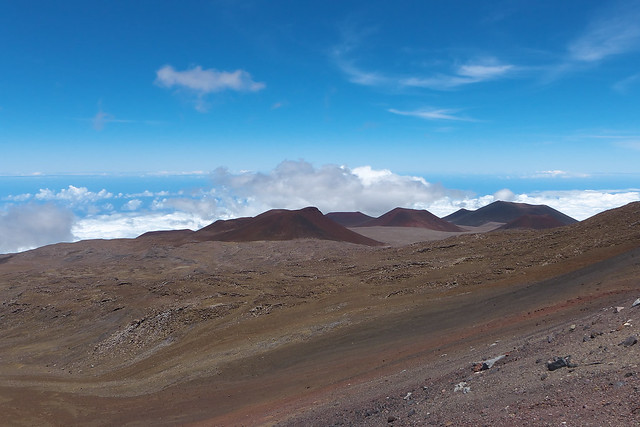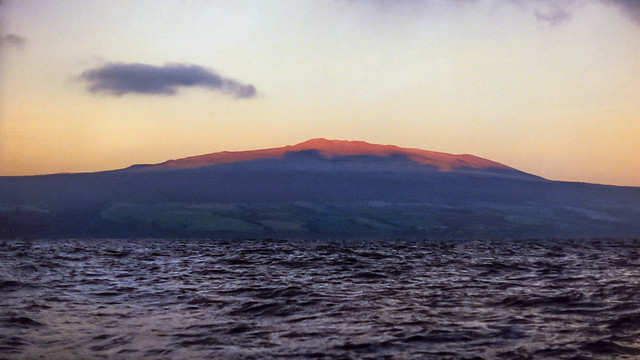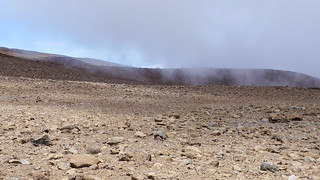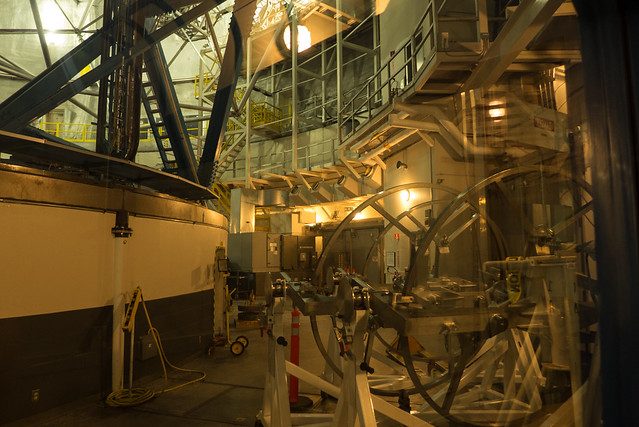
In the predawn darkness of an early morning many summers ago, standing on a 35-foot sailboat off the coast of Hawaii’s Big Island, a young man watched in awe as the sun lit up a mountain nearly three miles high.
He’d been awoken from his cramped little berth in the bow of the boat a few hours earlier. It was his final turn at standing watch for a 25-day passage from San Diego with a 75-year old skipper and a crewmate in his 40s named Roy. Recalling that magical morning upon his return home, the young man wrote:
I crawled out into the cockpit and was startled by the sight of flickering pinpoints of light clustered near the western horizon. I spent the next several hours before dawn watching the panorama of lights unfold around the boat as it drifted toward the island.
“It was an enchanting sensation,” his flowerly prose said, full of youth and vivid memory, “after a month on the open, forlorn sea, to stand out in the cockpit, trying to steer the boat through an almost dead calm, contemplating these silent announcers of civilization.” The towns north of Hilo appeared to him as
neat little arrangements of lights on the slopes of the island, whose only sign of existence was a faint outline of black land against starry, black sky. An airport beacon flashed at regular, hypnotizing intervals. Tiny navigation lights blinked red, white, and green directions.
I felt a sort of distant kinship for the faceless humans who slept beneath those lights, some 15 miles away. I had stared at two haggard, bearded faces for a month, and hungered for the smiles, laughs, and speech of the people of the island of Earth.
Now, with the arrival of sunlight skirting past a bulge of ocean clinging to a round planet, the long-dormant red lava at the top of Mauna Kea glowed like a torch. The boat was still in the earth’s shadow; it was dark everywhere else he could see but that blazing mountaintop. The young man grabbed the 35mm camera he’d borrowed from his mother and snapped this picture:

Then he watched the light creep down the mountain as the earth’s shadow retreated, toward a patchwork of sugar cane fields on the lower slopes and finally the surrounding sea. “The massive island off our starboard beam began to glow with the sunshine, shining its beautiful deep green shades through the morning mists. Furtive sheets of clouds raced across the higher mountains, shrouding them from our sight.” At this point, the boat was about a mile off the coast.
I was seventeen years old.

Last summer, my wife and I drove a rented Toyota Forerunner to very nearly the top of that massive island. We parked it next to the silver dome of the NASA Infrared Telescope Facility at 13,674 feet above the sea level where we’d awoken that morning. It was within a hundred and fifty feet of Mauna Kea’s summit elevation, a long ways to climb in such a short time even with a four-wheel drive vehicle doing all of the work. The engine had gotten slow and hesitant above 12,000 feet or so, and our brains were, too.

A few days earlier on Maui’s Haleakala Crater, I’d experienced the slightly panicked sensation of being winded while just standing still. And that was nearly a mile lower, 10,023 feet above sea level. We staggered out of the Forerunner with 40% less oxygen in every breath than we’d had with this morning’s breakfast, and we were feeling it.
When I knelt down to take pictures, I could feel the immediate effect of my legs pushing up against my chest cavity and preventing deep breaths. This wispy air demanded consumption in big gulps. Gasp, gasp, click. Stand—dizzy, unsteady—and breathe fast without feeling like the body’s getting caught up.

But what scenery there was! The Pacific Ocean stretched out miles below and away from us, dark solid blue below its patchy clumps of cloud cover. And we were well above those clouds. So, more pictures. Gasp, gasp, click. And gasp some more.
“Shortness of breath” and “impaired judgment,” warns the visitor information station. “Reduced atmospheric pressure at high altitudes may cause altitude sickness or result in the development of other life threatening conditions such as pulmonary edema (fluid in the lungs) and cerebral edema (fluid on the brain).”
My wife was a reluctant visitor to this godforsaken outpost in the sky, much preferring the tourist-friendly packaged comforts of Honolulu. She looked around for a few minutes and sat down in some patch of man-made shade. She did not join me in expressing awe about the view or the grandeur of the planet. She wanted to go down, now.
“Also,” the visitor information station sternly continues, “because the summit is above much of the atmosphere that blocks the sun’s damaging ultraviolet rays, you risk exposure to serious sunburn and eye damage.” I kept my sunglasses on and applied generous amounts of sunscreen.
Was the sky really a bit darker blue up here, or was that my imagination? It also didn’t feel as cool as it should have, given how much lower the Forerunner’s thermometer was saying the temperature was than it had been down at sea level. Were the sparser air molecules doing noticeably less of a job at ferrying heat away from my body? That might’ve been my engineer’s imagination, too. But limited convection was a real concern for the rental agency when it came to overheating the brakes on the drive back. Use the engine to slow down, their brochure said, because the brakes can’t cool off enough in the thin air.
I saw (and heard) more tangible evidence of how thin that air was from a water bottle that I’d emptied and opened at the top. Its flimsy plastic walls crunched and popped as the atmosphere thickened outside it during the drive back down the mountain. We stopped to use the bathroom at the visitor’s center and took easy breaths of air that felt rich and generous at 9,200 feet. Closed and still crumpled up at the 2,000 foot elevation of my Eastern Washington home, the bottle now sits on my shelf as a souvenir.
In the space of six hours, I went from the bottom of Earth’s atmosphere to a point where there’s less than half of it left, and then back again. It was quite a day.

What will never fail to impress me after taking a month to do a Pacific crossing is the gigantic scale of it all. That huge, dramatic mountain-that-is-an-island, rising nearly three miles above the Pacific and much further still from the seafloor beneath, is just a barely visible zit on the surface of our remarkably smooth ball of a planet.
Imagine a blob of Silly Putty that you’ve smooshed into an irregular, flat pancake with a couple of little lumps near the middle. It’s a relief map of Hawaii’s Big Island, and the tallest bump (not by much) is Mauna Kea. (The next biggest one, 99.1% as high, is Mauna Loa.) Your flattened blob-map is about seven inches across at its widest and only a quarter of an inch high.
To mash this onto the surface of something representing the earth, at its proper scale, you’d need a very big globe. Really big. Its diameter would be about 63 feet.1
Mauna Kea is just a flat little bump. You couldn’t even tell it was there if you looked at this giant globe from fifty feet away, just far enough to see the whole thing in profile. Earth deviates from a spherical shape by 43 km, an equatorial bulge at the planet’s waistline from the centrifigal force of twirling around once a day. That wouldn’t be noticeable, either, but it’s a full ten times as much as Mauna Kea’s height.
We don’t appreciate such enormities, because they dwarf us. “When I consider thy heavens, the work of thy fingers, the moon and the stars, which thou hast ordained,” asks the Psalmist, “what is man, that thou art mindful of him?” Ancient cosmology aside, he was onto something there. We are mere specks. The bacteria your hands would have left on that blob of Silly Putty when forming it are about the same size, on this scale, as I was standing on that mountain.2

Notes
-
The scale is 662,520. In metric, and with more precision, the dimensions of the model island would be 18.4 cm across by 6.35 mm high. (That might require a couple of eggs’ worth of Silly Putty.) The globe would be 19.23 m in diameter. ↩
-
Bacteria range in size from half a micrometer to five μm. The height of a scaled-down human, say 2m orginally, would be 3 μm. The enormity of scale continues as things get bigger: A model sun would be just over a mile across and about 140 miles away (2.1 km and 225.8 km, respectively). ↩
